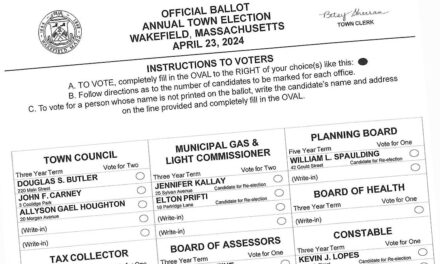Published in the January 16, 2018 edition.
By MARK SARDELLA
WAKEFIELD — His written report isn’t due for another week, but yesterday the selectmen’s Transmission Line Subcommittee got a fairly clear indication of what consultant Robert Kavet will say about the potential health risks of National Grid’s proposal to run 3.5 miles of 345 kV underground transmission line through town.
Leaving the specifics of Wakefield’s situation for his official report, Dr. Kavet was forthright in expressing his belief that there is no significant health risk from exposure to electromagnetic fields (EMF) at the levels expected from a transmission line like the one proposed in Wakefield.
Dr. Kavet was retained by the town to analyze the health risks associated with the proposed underground line in Wakefield, which is part of an 8.5-mile National Grid/Eversource line that will run from Woburn through Winchester and Stoneham before entering Wakefield. The proposed route of the project through Wakefield would come down Albion Street and Broadway, cross North Avenue and then follow the abandoned railroad bed for approximately one mile, running across Bennett Street, Richardson Street and Water Street. The line would then turn down Salem Street to Montrose Avenue and up the access road to the National Grid Substation.
The power companies have said, and regulators have agreed, that the line is necessary to assure energy reliability in the region going forward.
Kavet has been involved with researching EMF health and safety issues since 1978. He was closely involved in studies that included epidemiology, exposure assessment and laboratory studies covering cancer and pregnancy risks. He was hired by the town in the wake of a contentious public hearing in November where many residents raised questions regarding the health risks of EMF exposure. National Grid had agreed to pay the $20,000 price tag for his analysis on behalf of Wakefield.
Dr. Kavet spent nearly 30 years with the nonprofit Electric Power Research Institute (EPRI), which he admitted is funded by the power industry to study the effects of electrical power transmission, including EMF. However, Kavet stated that he has never had any personal or professional relationship with National Grid.
He currently serves as co-chair of the Institute for Electrical and Electronic Engineers’ subcommittee on electromagnetic safety concerned with establishing exposure standards. He has authored or co-authored about 100 peer-reviewed publications on EMF topics.
Dr. Kavet holds master’s degrees in electrical engineering (Cornell University) and environmental health sciences (Harvard School of Public Health) and a doctoral degree in respiratory physiology from Harvard School of Public Health. He is currently affiliated with the Harvard T.H. Chan School of Public Health as an instructor.
He was directly involved with EPRI studies on any possible association between electromagnetic field (EMF) exposure and diseases like cancer and childhood leukemia.
“Most mainstream scientific opinion doesn’t attribute the association to magnetic fields,” Kavet said.
He said that the National Toxicology Program (NTP) has reported to the federal government on the results of many studies it did on rats and mice to see what substances and exposures could be potentially carcinogenic to humans. Kavet said that NTP has created lists of dozens of exposures known to be carcinogens and an even longer list of things that are reasonably expected to be carcinogens.
“Magnetic and electric fields don’t appear on either list,” Kavet said. He noted that the NTP studies on EMF exposure in rodents were negative. He added that the absence of carcinogenicity in rodents “is very strong evidence that something is not carcinogenic in humans.”
Kavet did allow that there have been epidemiological studies that appeared to show an association between exposure to EMF above certain levels and childhood leukemia. But he cautioned that a study showing association does not mean EMF is the cause. He added that even the epidemiological studies offer reasons to believe that the cause of the association is not magnetic fields.
“There is little evidence that would support magnetic fields as the cause,” Kavet said. “I don’t personally see magnetic fields as a causal agent.”
Kavet went so far as to suggest that residents could be getting just as much EMF exposure from the lower power electrical distribution lines on poles running through every neighborhood as they would from a typical underground transmission cable. He noted that once you get 20 or more feet from a transmission line, the EMF levels drop dramatically.
Despite Kavet’s expressed conviction that there is no evidence of a causal relationship between EMF and health issues, many of the questions asked at yesterday’s meeting concerned mitigating EMF levels.
Subcommittee member Ed Dombroski said that he wanted Kavet’s final report to address whether using the alternate New Salem Street route, which has fewer residential homes, would be preferable to “preferred” route down Salem Street.
Kavet said that the choice of a route where fewer people would be exposed was a policy decision and “a little bit beyond my purview.” He also noted that water issues along New Salem Street could make that route problematic.
Subcommittee Anne Santos said that she wanted to wait for Kavet’s final report to find out if there was enough to worry about before focusing on mitigation issues like rerouting the line. She indicated that she was not yet convinced that the science warranted such measures.
Abutters serving on the committee, Michelle Bachman and Candice Del Rio posed questions related to how moving the position of the transmission line in the street or burying it deeper could mitigate EMF levels. Kavet said that it is always true that the EMF field decreases with distance from the source.
Subcommittee members said that Kavet was expected to deliver his written report on Jan. 22. Once the board reviews it, they said, it will be made public.




